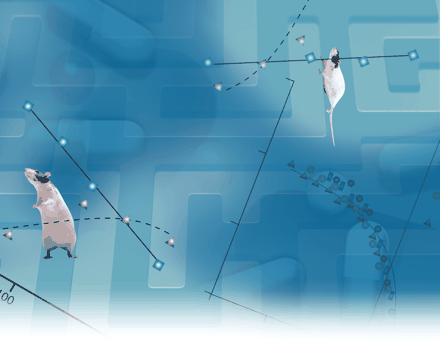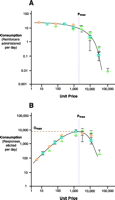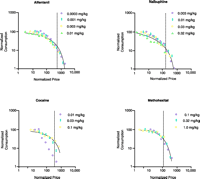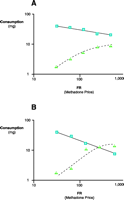The Economics of Drug Abuse: a Quantitative Assessment of Drug Demand
Abstract
Behavioral economic concepts have proven useful for an overall understanding of the regulation of behavior by environmental commodities and complements a pharmacological perspective on drug abuse in several ways. First, a quantitative assessment of drug demand, equated in terms of drug potency, allows meaningful comparisons to be made among drug reinforcers within and across pharmacological classes. Second, behavioral economics provides a conceptual framework for understanding key factors, both pharmacological and environmental, that contribute to reductions in consumption of illicit drugs. Finally, behavioral economics provides a basis for generalization from laboratory and clinical studies to the development of novel behavioral and pharmacological therapies.
Introduction
Prior to the 1960s, scientific evaluation of drug abuse and drug dependence was carried out primarily by pharmacologists. The emphasis at that time was on opioid abuse, and physiological dependence was thought to be the critical aspect of opioid addiction in humans. With increasing interest from experimental psychologists, the emphasis shifted to the behavior of drug-addicted individuals. Experimental models of drug taking were established, influenced largely by B.F. Skinner’s work on food-reinforced responding (1). In initial studies of rats (2) and rhesus monkeys (3), drugs were infused into jugular veins through catheters via remote, electrically activated pumps. By pressing a lever in their cages, the animals could repeatedly self-administer small amounts of drug over the course of an experiment. A drug was termed a reinforcer if its delivery, contingent upon a lever press, established and maintained responding (4).
Subsequent research found that animals self-administered many of the same drugs abused by humans. Cocaine, codeine, morphine, and even ethanol served as reinforcers when delivered intravenously in rhesus monkeys, although hallucinogens generally did not (5). Although the earliest studies of opioid taking used animals that had been made physically dependent on morphine, it was soon discovered that opioids maintained lever-press responding in the absence of dependence (6). In addition, drugs such as cocaine and amphetamine failed to produce strong physiological dependence or withdrawal, but effectively maintained drug-taking behavior. These findings supported the notion that physical dependence was not a necessary antecedent to the establishment and maintenance of drug-taking behavior. Rather, it was the reinforcing effects of drugs that were now considered paramount to physical dependence per se in the development of drug abuse.
When psychologists joined with pharmacologists to study drug abuse, both fields of endeavor were enhanced. The psychologists came from a behaviorist tradition in which the relationship between the response requirement and the reinforcer delivery was a critical, independent variable, and the rate of responding was an index of the value of the reinforcer. They were therefore interested in determining how drug-taking behavior would change if the animal were required to make a number of responses before each unit of drug was delivered. The pharmacological tradition emphasized the importance of amount of drug delivered (mg/kg/injection) to the development and maintenance of drug self-administration. In combination, these two approaches resulted in fairly standardized studies of drug self-administration in animals. Typically, completion of a fixed number of responses [termed a fixed-ratio (FR) response requirement] is required for drug delivery. Across sessions, the amount of drug delivered as the reinforcer [i.e., dose (mg/kg/injection)] was manipulated in randomized fashion.
In these types of experiments, response rate is plotted as a function of drug dose, typically resulting in a bell-shaped dose-response curve. When the dose per injection is quite small, animals emit relatively few responses and only receive a few injections. At higher doses, response rates increase and animals receive more injections. The dose that maintains the highest rate of responding can be empirically determined; if even larger doses per injection are tested, rates of responding begin to decrease, although total session drug consumption typically increases.
The classic bell-shaped dose response curve has been a point of contention for behavioral pharmacologists for some time. If the rate of responding is thought to reflect, in a general way, the reinforcing strength of the drug dose being delivered, why do rates of responding decrease when larger doses per injection are made contingent on responding? It cannot be concluded that larger doses are less reinforcing than smaller doses, because when animals have the opportunity to choose between large and small doses of a drug, they consistently prefer larger doses (7). Thus, the decreased rates of responding observed at higher doses appear to be caused by negative feedback. Whether this negative feedback represents drug-specific satiation, as opposed to the suppression of a more general (e.g., locomotor) response, continues to be debated. It is clear, however, that rates of responding will not necessarily reflect the relative reinforcing effects of drugs and drug doses. In other words, one cannot compare the reinforcing strength of two drugs by simply comparing the maintained rates of responding.
An ideal solution to this problem would be to quantify the reinforcing effects of drugs independently of dose. Although this has proven difficult, recent advances in behavioral economics have allowed investigators to begin to quantify drug demand in precisely this manner. In this article, we will illustrate how basic principles of behavioral economics may be applied to complement molecular interventions of drug abuse.
Behavioral Economic Concepts
The field of behavioral economics, a relatively new approach to the study of behavior, attempts to apply concepts developed by micro-economists, such as consumer demand and labor supply theories, to help understand how the behavior of single organisms is maintained by various reinforcers, or “commodities” (8). Concepts of behavioral economics have proven useful for understanding the environmental control of overall levels of behavior for a variety of commodities (9–12). Behavioral economics has been particularly successful in analyzing the self-administration of drugs in both animals and humans (13–21).
Behavioral economic studies consider total daily consumption of a commodity, rather than overall response rate, as a fundamental index of the demand for that commodity. In the studies we will describe, subjects control their own level of consumption by responding on a lever or key to earn small units of one or more commodities.
Demand-Curve Analysis
The relationship between the consumption of a commodity and its cost is described by a “demand curve,” which generally shows that as the cost of a commodity increases, consumption decreases. In the study of rhesus monkeys shown in Figure 1A⇓ (21), the cost of a commodity (e.g., food and saccharin-sweetened water), is operationally defined in terms of the number of times a lever must be pressed in order to earn a single, small unit of that commodity (i.e., the FR requirement). Across daily sessions, the FR can be gradually increased (Figure 1⇓) in a closed economy (i.e., the only source of the commodity is that provided in accordance with the FR requirement). As the FR is increased, the rate at which consumption levels decrease, reflecting the behavioral sensitivity to price, relative to the level of consumption at the lowest price is called “elasticity of demand.” Demand is “inelastic” when consumption declines only by small amounts with proportionately large increases in price. To use a familiar example, when the cost per gallon of gasoline increased three-fold during the 1970s, from thirty-three cents to over one dollar, consumption decreased by only 10% (21); this was an example of inelastic demand, and a result was that a larger share of household budgets was allocated to gasoline. In the experiment shown in Figure 1⇓, food is a relatively inelastic commodity; across a range of increasing prices, monkeys maintain a similar level of consumption by increasing their total response output (Figure 1B⇓). By comparison, consumption of saccharin-sweetened water by the monkeys (who had an alternative source of plain water), is elastic; as the price of saccharin increases, consumption declines rapidly.
Demand curves describe the relationship between the cost and consumption of behavioral reinforcers. The cost incurred by a rhesus monkey working for either food (squares) or saccharin-sweetened water (triangles) is given as the number of responses (e.g., depression of a lever) required to elicit a unit of reward (e.g., a food pellet). This cost can be varied by the experimenter, whereby the ratio of responses per reward is fixed to a predetermined value [i.e., the fixed-ratio response (FR), plotted on the x axis]. Consumption can be given, on the y axis, as either the number of reinforcers given per day A. or the number of responses elicited per day B. See (21).
The distinction between elastic and inelastic demand defines a continuum, as is illustrated in Figure 2⇓. Consumption of all reinforcers becomes elastic if the price is elevated sufficiently (Figure 2A⇓). The price at the point of transition between inelastic and elastic demand is termed Pmax (Figure 2B⇓). If this transition occurs at relatively low prices, then demand for the reinforcer is generally more elastic than is demand for a reinforcer that sustains response rates over a broad range of prices. We use the term Omax to describe the maximal output of responding that occurs at Pmax (Figure 2B⇓).
Elasticity of demand. A. An organism’s demand for a given reinforcer is defined as elastic if consumption drops significantly as the unit price (i.e., FR divided by unit administered) of the reinforcer is raised. B. The maximal price (Pmax) of a reinforcer and maximal output of responses (Omax) of the organism under a given set of conditions are both parameters that can be used to describe behavior with regard to a given reinforcer. See text for details.
Measuring Demand
In order to use elasticity of demand as a basic yardstick for evaluating “motivation” for drug reinforcers (14), clear definitions of both consumption and price are needed. Hursh (9, 10) has proposed that consumption be measured in terms of total daily intake, which, for drug reinforcers, is the mass of drug intake per day adjusted for the mass of the subject (mg/kg/day). The unit price (P) of a drug would be defined as the number of responses (FR) required to supply the drug divided by the unit dose delivered (D; mg/kg/injection). An important implication of this equation is that unit price can be manipulated either by increasing the response requirement (i.e., FR) or by decreasing the dose (D).
These points are illustrated in Figure 3⇓, which shows consumption of ketamine as a function of unit price (responses per dose) in rhesus monkeys (22). Although the reinforcer is administered in any of three doses (mg/kg/injection), when total consumption is plotted against unit price, a single function emerges. Consumption declines in a curvilinear fashion as the unit price is increased, and the rate of change is independent of dose. Across a range of prices, demand is inelastic (i.e., to the left of the vertical line at Pmax). Monkeys maintain a similar level of consumption by increasing their total response output (Figure 3B⇓). These data elegantly underscore the functional equivalence between increasing the response requirement and decreasing the dose.
The behavioral economics of ketamine consumption. A. Despite differences in the doses of ketamine made available to rhesus monkeys (green, 0.03 mg/kg; blue, 0.1 mg/kg; yellow, 0.3 mg/kg), the demand curves and economic parameters (e.g., Pmax) that describe usage of the drug are constant and thus descriptive for ketamine. B. Given that unit price P is equal to FR (expenditure) per dose (D), and given a constant Pmax for ketamine, it becomes clear that the monkeys must work harder at lower doses to maintain their intake of ketamine. [See (22).]
Normalized Demand
Although we have demonstrated how a single function that is independent of dose can describe demand for a drug, comparing demand among different drugs is problematic. The unit-price equation described above can only be used when the drugs under comparison are of equal potency. In order to compare drugs with different potencies, Hursh and Winger (23) have developed a normalization procedure, according to which maximum daily consumption observed at the lowest price investigated is taken as a reference level. Each dose is then expressed as a percent of the total daily drug consumed at the lowest price. For example, a drug that is consumed at an average baseline level of 100 mg/kg per day and is dispensed at the rate of 1 mg/kg per administration would have a normalized dose, q, of 1 percent. Normalized price and consumption are computed in terms of the q value. Normalized price (P) is the number of responses required to produce the unit commodity (FR) divided by its q value:

Normalized daily consumption (Q) is the product of total number of units administered per day (r) at a given FR and the q value for the given reinforcer:

Note that at the lowest price, normalized consumption (Q) will always equal 100; hence, all normalized demand curves have a starting level of 100 percent. Note also that normalized demand is formally very similar to unit price demand; the only difference computationally is that the normalization constant, q, is used everywhere that dose, (D) would appear (see above). In fact, normalized price is a type of unit price based on relative rather than absolute units of reinforcement. Expressing price and consumption in relative terms allows demand for different drugs to be compared, independent of both dose and potency.
Validation of the normalization procedure comes from studies investigating the reinforcing functions of drugs that act on the same receptor but with different efficacies. μ-Opioid receptor agonists are particularly helpful in this analysis because there are a number of compounds that have been shown, using both behavioral and in vitro measures, to differ in receptor efficacy. For example, alfentanil is a highly efficacious μ-opioid agonist, and nalbuphine is a partial agonist at the μ-opioid receptor (24, 25). Because both opioids have been shown to function as reinforcers, a rank ordering of these drugs according to their normalized Pmax and Omax values should correspond to their efficacies, which in fact is observed (24).
Figure 4⇓ shows normalized demand curves from rhesus monkeys self-administering four drugs from different pharmacological classes with widely varying potency (23). Note that the drugs may be distinguished by two basic factors: The elasticity of the demand curve indexed by normalized Pmax and the overall level of demand at Pmax (i.e., normalized Omax). The magnitude of Pmax may be thought of as the sensitivity of the performance to environmental constraints and costs, whereas the value of Omax may be conceptualized as the capacity of the drug to absorb the resources (budget) of the subject, or level of “drug seeking.” Although one might expect Pmax and Omax values to be related, Figure 4⇓ demonstrates that this is not always the case; methohexital has a lower Pmax value compared to nalbuphine but supports a higher Omax value. Nevertheless, these features of demand appear to be relatively dose-independent and may, therefore, represent fundamental properties of the drugs as commodities. The generality of this proposition still needs to be verified under a variety of behavioral and pharmacological assays.
Comparisons of demand for four distinct drugs. Normalization of demand parameters allows for the comparison of demand for four distinct drugs: alfentanil, nalbuphine, cocaine, and methohexital. [See text for details. Also see (23).]
There are other aspects of drug action that are of interest in the evaluation of the reinforcing functions of drugs. Two of these are onset and duration of drug action. μ-Opioid receptor agonists are useful in studying the impact of duration of action on the reinforcing effects of drugs because fentanyl and its derivatives, alfentanil and remifentanil, have similar efficacies and similar onsets of action but markedly different durations of action. When demand curves for these three drugs are compared, their normalized Pmax and Omax values are not significantly different from each other (26), which indicates that the reinforcing effectiveness of drugs is not dependent on duration of action. This finding is compatible with epidemiological data that indicate that cocaine, with a short duration of action, and amphetamine, with a much longer duration of action, are both widely abused.
Onset of action may be more important. The N-methyl-d-aspartate channel blockers ketamine, phencyclidine, and dizocil-pine are dramatically different in both their onsets and durations of action. Dizocilpine (MK801), with its slow onset, is less effective as a reinforcer than the faster acting ketamine and phencycli-dine (22), that is, dizocilpine has a significantly lower normalized Pmax than the other two drugs. With duration of action ruled out as an important contributor to the drugs’ reinforcing characteristics, onset remains as the potentially crucial factor. Again, epidemi-ological evidence supports this notion. The development of crack cocaine, which, when smoked, has a very fast onset of action through the lungs, led to cocaine use that was much more prevalent than use of snorted, and therefore slower acting, cocaine base.
Choice and Behavioral Drug Interactions
Within a behavioral economic framework, reinforcer interactions are classified into multiple categories; two commodities may be “substitutes” for one another (e.g., two forms of opioid drugs); they may be “complementary,” whereby the value of one is enhanced by consumption of the other; or they may be “independent,” such that the reinforcing functions of one are not altered by the presence or absence of the other. In the laboratory, interactions between two commodities can be assessed as follows: First, the price (response requirement) is raised for one of the commodities, holding the price of the second constant. If consumption of the second then increases as a function of the price of the first commodity, then the second commodity is defined as a substitute; if consumption decreases, then it is defined as a complement; and if it remains unchanged, then it is independent.
Figure 5⇓ illustrates this process with a human methadone patient (R. Spiga, unpublished work) who is able to make one behavioral response to receive 0.4 mg/delivery of methadone or make a second behavioral response to receive 0.15 mg/delivery hydromorphone. Across days, the number of responses for methadone is increased from 32 to 512 in five steps; the price of hydromorphone remains constant at 32 responses per delivery. The maximum amount of methadone that can be obtained in the session is 40 mg. In a first experiment, any unearned portion of the 40 mg is forfeited (closed economy). In a second experiment, the subject receives any unearned portion of the 40 mg at the end of the day (open economy). Consumption of methadone in the closed economy (Figure 5A⇓) decreases as a linear function (log plots) of price. Consumption of hydromorphone increases as a function of the price of methadone, indicating that hydro-morphone functions as a substitute for methadone. The same basic pattern is observed in the open economy (Figure 5B⇓), but the decrease in methadone consumption and the increase in hydromorphone consumption as a function of methadone price are greater. Thus, features of the open economy increase the “own-price” elasticity of demand for methadone and the “cross-price” elasticity of hydromorphone. The concept of substitution will be important later in our discussion of agonist interventions for treatment of drug abuse.
Behavioral economics provides a quantitative means to describe the demand for alternative drugs by a single organism. The graphs show the demand for methadone (squares) in the presence of hydro-morphone (triangles); the price of the latter is held constant (see text for details). The graph in A. represents a closed economy; the graph in B. represents an open economy. Data are from one human participant (R. Spiga, personal communication).
Complementarity between two drug reinforcers may also be observed in humans. Spiga and colleagues (27) conducted a similar experiment in which the alternatives were methadone and cigarette puffs (nicotine). Here, consumption of nicotine at a constant price decreased as the price of methadone increased, indicating a complementary relationship. By comparison, Johnson and Bickel (28) compared human choice between cigarette smoking and money and found that demand for money is independent of the price of cigarette puffs.
Implications for Treatments of Drug Abuse
Behavioral treatments of drug abuse attempt to establish a behavioral repertoire that is incompatible with illicit drug use. Alternative commodities and activities that compete with drug use can be modeled in the laboratory. For example, Carroll (29) found that rhesus monkeys’ demand for phencyclidine (PCP) becomes more elastic when an alternative non-drug source of reinforcement (saccharin) is provided. Pharmacological therapies for the treatment of drug abuse can also be conceptualized as alternative commodities that either substitute for illicit drug use (e.g., agonist therapy) or reduce the potency of illicit drugs directly (e.g., narcotic antagonist therapy).
A behavioral economic analysis of therapeutics offers three criteria for judging the effectiveness of treatment (21). First, the therapy must be behaviorally efficacious. Effective interventions should increase drug elasticity (reduce Pmax) and/or decrease the amount of behavior allocated toward drug procuring and use (reduce Omax). Second, the therapy should be behaviorally safe. In addition to selecting treatment drugs and doses that have minimal pharmacological side effects, the therapy should not alter demand and/or response output (i.e., motivation) for socially desirable commodities. Finally, the treatment should be nonaversive. The demand for the therapy must be of sufficient strength to engender client compliance. A good example of a pharmacological treatment for drug abuse that meets these first two requirements but fails to meet the third is the use of disulfiram, an aldehyde dehy-drogenase inhibitor, for the treatment of alcohol abuse.
Heroin Addiction
The effectiveness of pharmacological therapies for drug abuse ultimately depends on a number of factors, such as the amount of direct substitution between the therapeutic and illicit drug (agonist therapy), the ability of therapeutic antagonists to reduce the potency of illicit drugs, and the presence of behavioral complements that may maximize therapeutic effectiveness. These factors will be illustrated by considering several pharmacological treatments for heroin addiction.
Agonist Therapy
Approximately eight million people in the world abuse opiates. According to the National Institute on Drug Abuse, 404,000 people in the United States report using heroin in the past year, and 3.7 million people over the age of twelve have tried heroin at least once in their lives.
In general, agonist therapies for drug abuse can be conceptualized as substitutes for illicit drugs. To date, the gold standard for the treatment of heroin abuse is methadone maintenance (30). Methadone is a long-acting opioid agonist that prevents the occurrence of withdrawal symptoms but does not produce a pronounced euphoria when administered orally. To a lesser extent, levoacetylmethadol (a derivative of methadone), also has been used to treat heroin abuse. Recently, buprenorphine, a partial opi-oid agonist, has been used in combination with naloxone as substitution therapy. Because of its long duration of action, buprenor-phine can be administered less frequently than methadone (31).
These opioid agonists are admittedly imperfect substitutes for heroin. Although they share many behavioral effects with heroin and prevent withdrawal symptoms, they do not produce as much euphoric high when administered orally. In addition, the self-administration of heroin is often associated with conditioned and social reinforcers that may be absent in the therapeutic setting (32). Perhaps due to a combination of these factors, agonist therapy itself often does not completely eliminate heroin use. Indeed, the effectiveness of treatment may vary with the street price of heroin, the dose of the agonist, and the costs associated with compliance, such as the distance to the clinic (21). Nevertheless, agonist therapy for the treatment of heroin abuse has been successful at increasing demand elasticity for heroin, especially when combined with behavioral treatments described below.
Antagonist Therapy
Whereas agonist therapies attempt to decrease heroin use through substitution, antagonist therapies attempt to reduce demand directly by blocking the behavioral and pharmacological effects of heroin. Antagonists themselves produce few untoward effects. Common antagonist treatments for heroin abuse include naltrex-one, and in the future, sustained-release formulations of naltrex-one or other antagonists will become available (33–35).
Antagonist therapy such as naltrexone should increase the functional price of heroin, as more heroin is required to produce the same behavioral effects. Competitive antagonists should not [and in fact do not (21)] modify the elasticity of demand for the agonist, because the antagonist simply decreases the potency of the agonist, and potency, as described above, is not a factor in demand curve elasticity. It is not surprising then, that the primary problem with antagonist therapy for heroin abuse is client compliance (30). Addicts generally do not volunteer for a treatment that will functionally increase the street price of heroin, especially when the underlying demand for heroin remains unchanged. Sustained-release antagonist therapies, if proven effective in clinical trials, may circumvent the compliance problem. A complementary strategy is to employ behavioral treatments in combination with antagonist therapy.
Behavioral Therapy
Behavioral therapies are often used in conjunction with pharmacological interventions and usually involve employment opportunities or participation in individual or group activities (36). One goal of such treatments is to expose the client to alternative sources of reinforcement that force a tradeoff between drug use and these alternative commodities, an economic concept known as “interdependent choice.” The “opportunity cost” of drug taking is defined as the forgone value of the commodity not chosen (37). For example, if an addict has a choice between an illicit drug and $100 and chooses the drug, the opportunity cost of that drug choice would be $100.
Given the limitations of the therapeutic situation, it is often difficult to foster contact between the client and naturalistic reinforcers (e.g., employment) that effectively compete with drug use. One solution has been to explicitly arrange incentives for behavior incompatible with drug use within the therapeutic setting. A powerful application of the principles of interdependent choice with methadone-maintenance patients has been developed using voucher-based opiate abstinence reinforcement (38, 39). Voucher-based programs arrange for clients to receive vouchers exchangeable for money whenever they attend the drug treatment clinic as scheduled and abstain from illicit drug use as verified by urinalysis. The longer the client remains drug-free, the larger the amount of money earned for each drug-free day; however, if the client consumes a detectable amount of drug, then the voucher is forfeited and the value of vouchers is reset to the initial value. In essence, the client can choose to consume drug or to take money, but not both. Such procedures have proven effective in increasing abstinence from both opiates and cocaine (38–45). Although some may find this sort of “pay for abstinence” objectionable (in some examples of this system, clients can earn in excess of $3000 for remaining drug free), these programs can be sustained as independent economies. For example, Silverman and colleagues (45) describe a program in which the money used to reinforce drug abstinence was earned by clients performing job skills in the community.
Conclusions
Behavioral economics complements a pharmacological understanding of drug abuse in several ways. First, the demand curve for drug reinforcers provides a quantitative metric of “motivation” to procure and consume drugs (14). Second, this analysis can compare demand for drug reinforcers from both the same and different pharmacological classes by normalizing differences in potency. In these analyses, the relation between demand and isolated pharmacological properties (e.g., onset of action) of diverse drugs can be determined. Third, behavioral economics provides a way to conceptualize pharmacological treatments for drug abuse, provides quantitative criteria to assess treatment efficacy in the laboratory, and offers suggestions to improve existing therapies. Finally, the behavioral economic model permits the findings from molecular and behavioral experiments that elucidate basic biological processes to be translated directly into implications for treatment and government policy. Behavioral economics thus provides a convenient framework and language for translational research on drug abuse.
Acknowledgments
The authors gratefully acknowledge support from the NIDA (R01DA15449) and NIAAA (AA013713).
- © American Society for Pharmacology and Experimental Theraputics 2005
References

Steven R. Hursh, PhD,(not pictured) is a research scientist and consultant for Science Applications International Corporation. He pioneered the use of economic concepts to account for behavioral phenomena within experimental psychology. James H. Woods, PhD, is a professor in the Departments of Pharmacology and Psychology at the University of Michigan. Gail Winger, PhD, is a research professor in the Department of Pharmacology. Chad M. Galuska, PhD, is a postdoctoral researcher in the Department of Pharmacology. Their interests include assessing the reinforcing functions of drugs in rhesus monkeys. Address correspondence to CMG. E-mail cgaluska{at}umich.edu; fax 734-764-7118.









